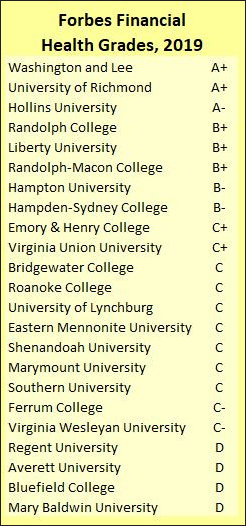
by James A. Bacon
With the college-age population expected to drop 15% between 2025 and 2029, Virginia’s 28 private liberal arts colleges are facing hard times ahead. And Governor Ralph Northam’s proposal to make community college free for lower-income students won’t help. The tuition gulf between private colleges and publicly supported colleges will get only wider.
Writing in the Richmond Times-Dispatch, Phyllis W. Jordan, editorial director of the Washington, D.C.,-based FutureEd think tank, raises the alarm. The private colleges, many of which are located in small towns and rural areas, are economic anchors of their communities. If they fail, they knock out an economic underpinning of communities with few alternative sources of business activity and employment.
So, what’s the solution? Unfortunately, Jordan’s proposal — to match bigger state subsidies of public colleges with bigger subsidies for private colleges — is just plain awful. Subsidies replace one set of problems with a different set of problems.
While Jordan’s proffered solution is terrible, the dilemma she describes is real. Fertility rates are dropping, fewer young people are emerging from the K-12 pipeline, and college enrollments are shrinking. Higher ed in the United States is suffering from overcapacity. Public institutions have about 6.4% excess capacity, she says, while small private colleges have about 28%.
Not only is there excess capacity in the higher-ed system but small private colleges lacking large endowments (which is most of them) suffer a competitive disadvantage against public institutions receiving millions of dollars in state support.
In a recent analysis of the finances of 933 private not-for-profit colleges with enrollments greater than 500, Forbes found that the wealthy, elite schools are getting richer and most of the rest are getting poorer. A Forbes financial ranking gave eleven Virginia colleges grades of C or C+, and four grades of D.
Virginia’s private colleges employ 23,500 people and pay $1.2 billion in salary and benefits. “When economists contemplate how to revive struggling rural areas,” Jordan says, “they often recommend opening colleges in these communities can ill afford to let this institutions die out.”
Virginia does offset a part of the competitive advantage by granting up to $3,200 in grants who attended private colleges in the state, and Governor Ralph Northam calls for raising that amount to $4,000 annually. On the other hand, Northam also calls for boosting state support to public colleges, and he proposes spending $145 million to make community college essentially free for low- and moderate-income students. Four thousand dollars for private colleges is not enough, says Jordan. “He could easily double that and still spend far less than the dollars devoted to community college.”
Whoa, Nelly!
Free college is a bad idea all around. Sure, one can argue that it’s in the public interest to make college more affordable, especially for students from lower- and moderate-income families. We want to provide avenues of upward social mobility for everyone. But one can also argue that students and their families need to make some sacrifices on their own behalf. They need to have skin in the game. If they don’t, many students might utilize public resources carelessly or frivolously. While Jordan may be comfortable with the idea of tapping taxpayers for another $480 million (120,000 full-time-equivalent students at $4,000 a pop), the idea can’t be taken remotely seriously.
Three points worth making:
- It’s interesting to note that Jordan is not urging bigger subsidies for private for-profit colleges with whom the private non-profits compete with no tax breaks or public subsidies of any kind. Why should the private nonprofits be privileged?
- A preferable way to make public and private nonprofit colleges more affordable is not to continue subsidizing them but for them to cut costs. Indeed, subsidizing higher-ed institutions insulates them from the necessity of making hard choices.
- Private nonprofit colleges not blessed with giganzo tax-privileged endowments have to be innovative to survive. They need to re-engineer their cost structures. They need to identify niches where they can excel and compete.
No one weeps for private colleges — which, to repeat, don’t receive any state subsidies or tax breaks — when market conditions force them to restructure, downsize or go out of business. What possible claim should private non-profits have on the taxpayer?
Yeah, I get it, private nonprofit colleges are anchor institutions in rural areas that can ill afford to lose the jobs. But the same can be said for coal mines, timber mills, or aging manufacturing plants, or any number of other types of employers — and we can’t subsidize them all just to support rural jobs. When there’s excess capacity in the coal industry, coal companies shrinking by shedding their least productive assets. That’s the way it works for every industry. That’s the way it should work — it’s how the economy reallocates resources from low-return uses to high-return uses. It should work that way in higher-ed, too.

Leave a Reply
You must be logged in to post a comment.